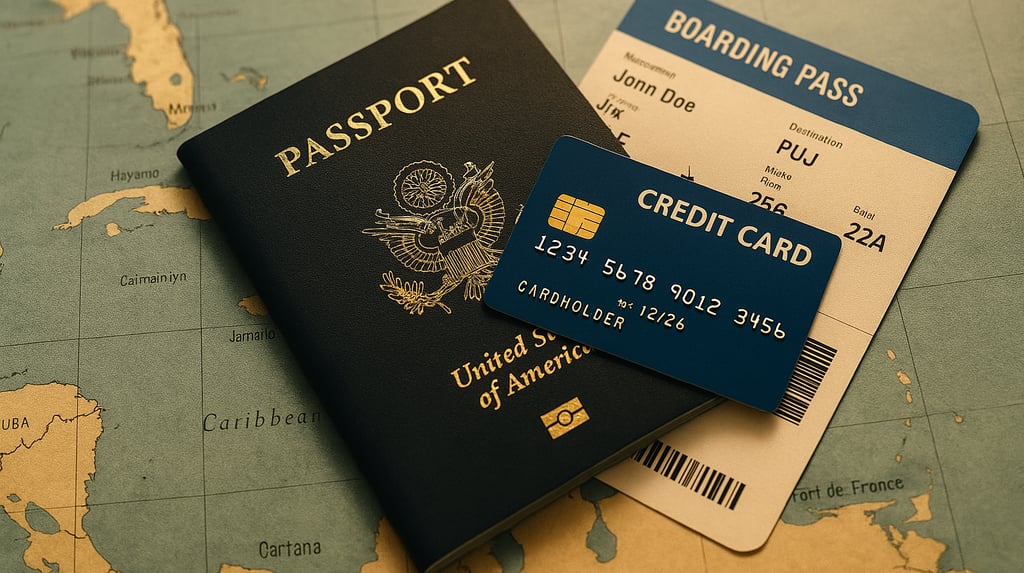FOR INFORMATION ON INSURANCE SOLUTIONS CALL OR WHATSAPP +1 849-514-9838 | info@hernandezpeguero.com
Credit Card Travel Insurance vs Standalone in the Dominican Republic (2025)
Planning a DR trip? See what credit card “travel insurance” really covers vs a standalone policy—medical limits, medevac, delays, exclusions, and when to buy.
HernandezPeguero.com
10/8/20255 min read


Credit Card Travel Insurance vs. Standalone Policies for Trips to the Dominican Republic (2025 Guide)
If you’re flying to Punta Cana, Santo Domingo, or Las Terrenas this season, you’ve likely wondered: is my credit card’s “travel insurance” enough—or should I buy a standalone policy? The answer depends on your trip cost, your medical risk tolerance, and how much fine print you’re willing to manage. This guide breaks down the differences so you can choose confidently for your Dominican Republic travel.
Quick Take: When Each Option Makes Sense
Your card may be enough for simple, low-risk trips where you’re mainly concerned about trip delay or lost baggage, and you have strong primary CDW (car rental damage waiver) benefits and modest medical needs.
A standalone policy is the safer bet when you want high emergency medical limits, reliable medical evacuation, pre-existing condition coverage, cancel for any reason (CFAR), or you’re traveling during hurricane season and need robust trip cancellation triggers.
If you want a deeper overview of what travel insurance covers, see our Travel Insurance in the Dominican Republic: Complete Guide for context.
What Credit Card “Travel Insurance” Usually Covers
Most mid- and premium-tier cards include a bundle of protections designed around trip value—not around medical care. Typical inclusions:
Trip Cancellation/Interruption for covered reasons (e.g., illness, severe weather, jury duty).
Trip Delay after a minimum delay threshold (e.g., 6–12 hours), reimbursing meals/hotel.
Baggage Delay/Loss with per-item caps and documentation requirements.
Rental Car Damage Waiver (CDW/LDW) on eligible rentals when you pay with the card and decline the counter’s CDW.
Common gaps/limits vs. a full policy:
Lower or no emergency medical coverage. Some cards offer little or none, or coverage that only reimburses after your personal health plan.
Medical evacuation (medevac) may be limited, secondary, or excluded. Air ambulance from the DR can be extremely costly; benefits vary widely. For a deeper look at evacuation needs, see Medical Evacuation in the Dominican Republic: 2025 Guide.
Strict definitions & exclusions. Pre-existing conditions, adventure sports, or family member illness back home may not qualify unless precisely defined.
Coverage only if you paid the trip with the card. Miss that requirement and benefits can evaporate.
Claim limits that may not cover premium resorts, peak-season airfares, or extended stays.
Bottom line: Cards shine for logistics (delays, baggage) and can be decent for rental car damage, but they’re rarely designed to be your primary health & evacuation solution in the Dominican Republic.
What Standalone Travel Insurance Typically Adds
A standalone DR-focused policy is designed to protect people and health first, not just trip receipts. Key advantages:
High Emergency Medical Limits
Plans often start around US$50,000–US$100,000 for emergency medical, with higher options available—more appropriate if you prefer private clinics or international evacuation pathways.Medical Evacuation You Can Count On
Air ambulance to the U.S. or your home country can run well into five figures. Standalone policies typically include dedicated medevac coordination, higher limits, and clearer triggers. (For evacuation specifics in the DR context, review our Medevac guide.)Pre-Existing Condition Waivers
Many policies let you waive the pre-existing condition exclusion if you purchase soon after your initial trip payment—something most card benefits don’t offer.Cancel For Any Reason (CFAR)
Optional upgrade (time-sensitive) that reimburses a percentage of nonrefundable costs even if your reason isn’t on the “covered reasons” list.Adventure Sports/Activities Options
If you plan on zip-lining, surfing, or diving, standalone plans often allow a sports rider to close the gaps.Clearer Claims Path
You’re not navigating a card issuer, a third-party administrator, and a bank portal; you’re dealing with a travel insurer built for this.
Five Questions to Decide What You Need
If someone in my party had a medical emergency, would I want private care and/or evacuation?
If yes, lean standalone with robust medical + medevac.Do I have any pre-existing conditions (or close family with health concerns that could affect the trip)?
If yes, look for pre-existing condition waivers—a hallmark of standalone policies when purchased early.Am I traveling during hurricane season or with multiple connections?
You’ll appreciate broader cancellation triggers and trip delay protections.Will I rent a car?
Some premium cards provide excellent primary CDW (damage to the rental). But this doesn’t replace third-party liability in the DR. Consider how you’ll handle liability exposures and medical coverage while driving days are part of your trip.What’s my hassle tolerance?
If you’d rather not decipher card eligibility rules (entire fare paid with card, closed-loop carriers, cardholder vs companion rules), a standalone policy is simpler.
Common Misconceptions—Cleared Up
“My card covers medical, so I’m fine.”
Often not at levels you’d want, especially for evacuation. Verify limits and whether the benefit is secondary to your home health plan.“CDW means I’m fully covered in a rental.”
CDW generally covers damage to the rental car, not third-party liability or injuries. Your personal liability exposure in the DR remains a separate issue.“I can buy a policy later if a storm forms.”
Insurance is about unforeseen events; once a named storm exists, many protections won’t apply unless you already purchased coverage.
For broader planning and definitions, you can cross-reference our DR Travel Insurance Guide.
How to Combine Both—Smartly
Plenty of travelers use both: rely on card perks for delays/baggage/CDW and buy a lean standalone plan focused on medical + medevac. This combo keeps costs sensible while covering catastrophic risks. If you’ve booked a luxury resort week or peak-season flights, consider upgrading the standalone portion to protect your nonrefundable trip investment more completely.
When to Buy
As soon as you make your first trip payment. This is critical to qualify for pre-existing condition waivers and CFAR.
Before hurricane season peaks. The Atlantic season runs June 1–Nov 30; DR trips in this window benefit from buying early.
Group trips: Make sure every traveler has coverage that matches their needs; don’t assume your card extends benefits to companions equally.
Real-World DR Scenarios
Couple visiting Punta Cana with a premium travel card
Keep your card for trip delay and baggage perks, but add a standalone policy with US$100k–250k medical and high medevac. If you add excursions (ATVs, ziplines), consider a sports rider.Family during shoulder season with grandparents
Pre-existing condition concerns? Buy a standalone policy within the early purchase window to pursue the waiver, and choose higher medical/evacuation limits.Solo traveler with minimal prepaid costs
You might skip cancellation coverage to save money and focus on medical + medevac. Your card can still handle delays and baggage.
Internal Resources You’ll Find Helpful
Understand core protections and coverage options: Travel Insurance in the Dominican Republic: Complete Guide
See why evacuation matters in the DR context: Medical Evacuation in the Dominican Republic: 2025 Traveler & Expat Guide
Prefer personalized advice? Visit our Insurance Guides & Tips hub or use our Contact page.
External Resources Suggestions
Final Checklist Before You Decide
Do you have at least US$100k in emergency medical and high medevac limits?
Are pre-existing conditions addressed (via waiver) if relevant?
Do your payment method rules (paying with the card, booking on the same itinerary, eligible carriers) line up for card benefits?
Traveling in or near hurricane season or taking adventure activities? Consider CFAR and sports riders.
Keep receipts, medical reports, and delay/cancellation proofs—claims go smoother with documentation.
Why Choose Hernández Peguero Insurance Brokers?
When it comes to credit card perks vs. real travel insurance, the fine print can get complicated—fast. As a local, bilingual broker in the DR, we help you:
Select the right medical & evacuation limits for the Dominican Republic’s private clinic network and international evacuation needs.
Coordinate benefits so your credit card protections and standalone policy work together, not at cross-purposes.
Add riders smartly (sports, CFAR, rental liability considerations) without overpaying.
Get support during a claim, including guiding documents and communicating with the insurer while you focus on enjoying your trip.
Ready to Get a Quote?
Protect your Dominican Republic trip today with affordable travel insurance.
👉 Contact us now:
Phone / WhatsApp: +1 849-514-9838
Email: info@hernandezpeguero.com
Website: www.hernandezpeguero.com
We’ll guide you to the best plan for your trip so you can enjoy your stay with total peace of mind.
Hernandez Peguero
Your trusted partner for comprehensive insurance solutions.
Broker
Coverage
© 2024. All rights reserved.
